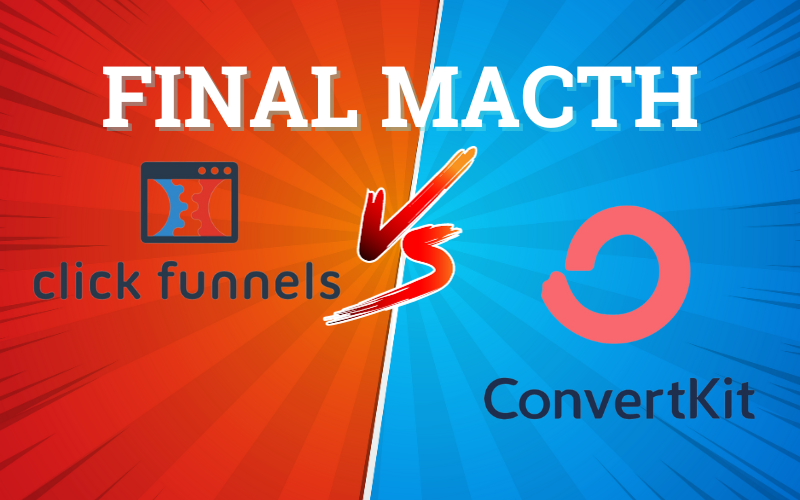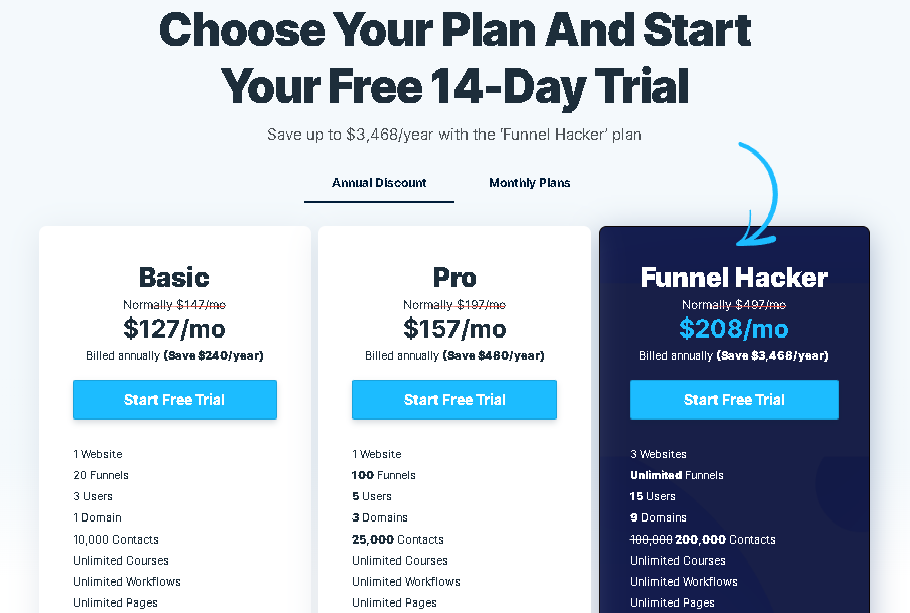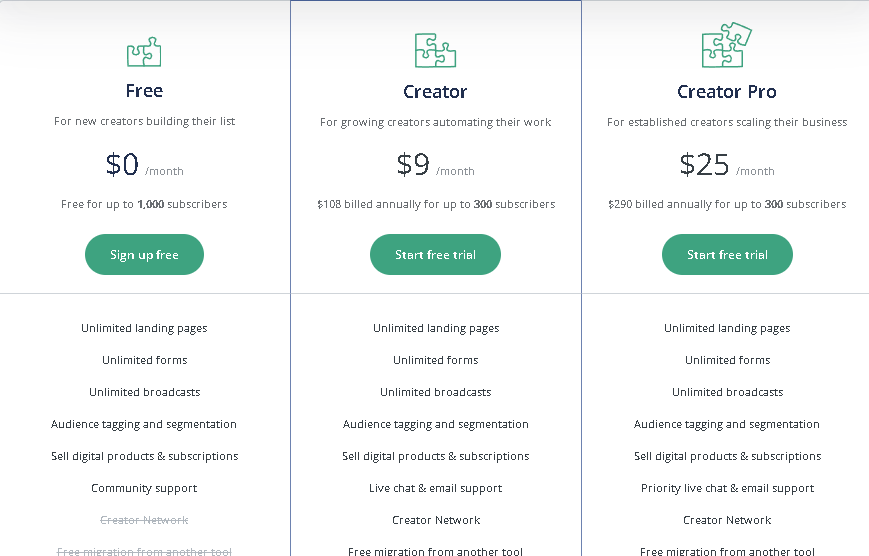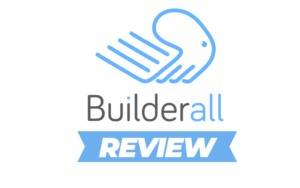We may earn money from the companies mentioned in this post. Your purchase won't cost you any extra, but it helps support the content and upkeep of this website. Thank you!
Navigating the dynamic world of digital marketing tools can be daunting. As you weigh the merits of “ClickFunnels vs ConvertKit,” it’s essential to understand their core strengths, functionalities, and how they align with your business goals. In this comprehensive guide, we’ll dissect each platform, offering insights to help you make an informed choice that propels your digital success. Dive in and let’s unravel the mystery together!
Table of Contents
ClickFunnels at a Glance
ClickFunnels, as the name might suggest, is all about building effective sales funnels. Think of a funnel as a guided journey you want your potential customer to take, starting from awareness to the final sale. ClickFunnels provides a platform where you can design landing pages, process sales, and handle email follow-ups – essentially, everything you need to guide a visitor to becoming a customer.
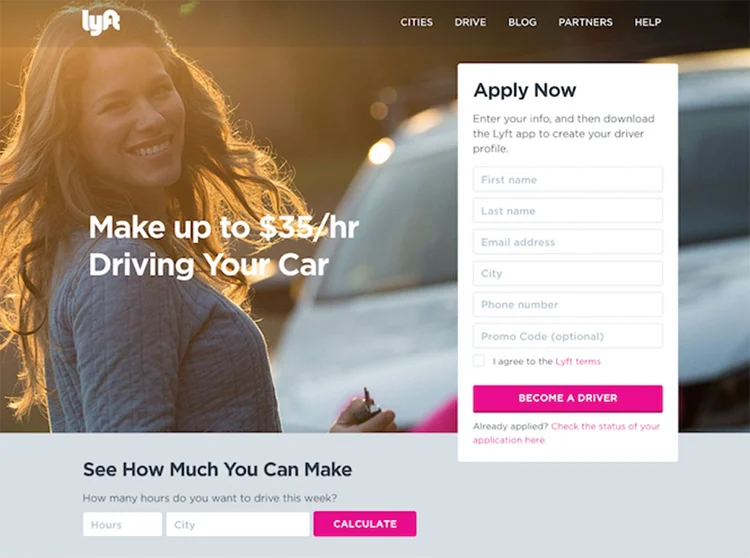
Diving Into ConvertKit
On the other hand, ConvertKit primarily shines as an email marketing tool. It’s designed to help creators – whether you’re a blogger, a YouTuber, or an artist – send out beautifully designed emails, segment their audience, and track engagement metrics. In essence, ConvertKit ensures that your messages reach the right audience at the right time, making email marketing feel like a breeze.
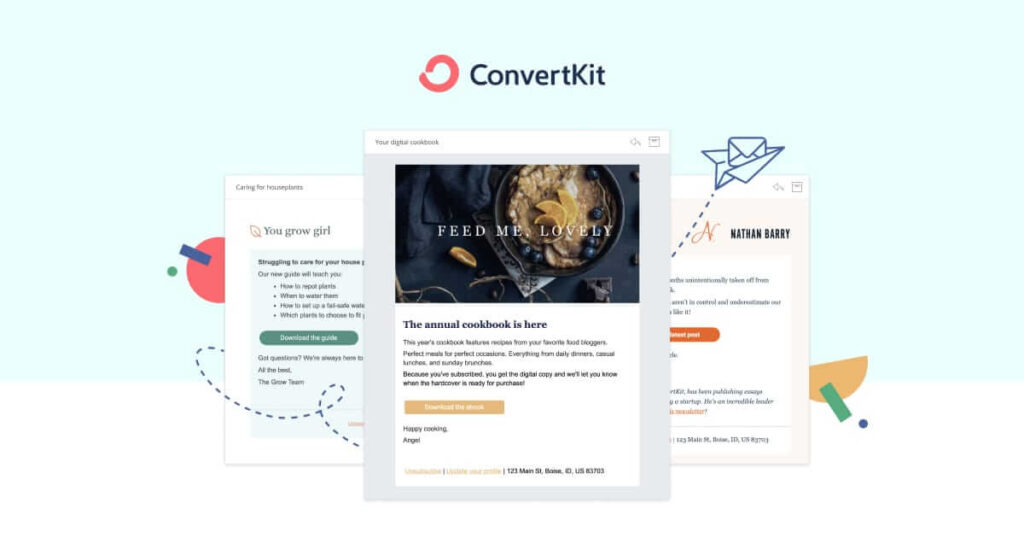
Both tools, while distinct in their core functionalities, aim to streamline and simplify the marketing process for businesses of all sizes. Whether you’re leaning towards ClickFunnels for its funnel-building prowess or ConvertKit for its email marketing finesse, you’re investing in tools built by experts for maximum impact.
In the upcoming segments, we’ll dive into a detailed examination of how these two platforms stack up regarding functionalities, cost, user interaction, and beyond. Keep reading for an in-depth analysis that can steer your promotional choices.
Core Purpose & Functionality
In the vast world of digital tools, every platform wears a unique hat. Understanding the core purpose and functionality of each tool is essential to harness its full potential. So, what are ClickFunnels and ConvertKit primarily used for? Let’s dive in.
ClickFunnels:
At its heart, ClickFunnels is like the architect of the online selling world. It’s designed to build sales funnels – structured sequences that guide visitors step-by-step from initial interest to the final purchase. With ClickFunnels, businesses and entrepreneurs can:
- Create captivating landing pages.
- Design checkout processes.
- Run webinars.
- Set up membership sites.
- And much more!
All these without needing a degree in tech wizardry! ClickFunnels streamlines the entire sales process, aiming to increase conversions and maximize revenue.
ConvertKit:
ConvertKit wears the hat of the communicator in the digital space. Primarily, it’s an email marketing tool but with a twist. Tailored for creators, ConvertKit allows users to:
- Send personalized emails to subscribers.
- Segment and tag their audience based on behavior and interests.
- Automate email sequences.
- Design sign-up forms and landing pages.
Its core mission? To help creators build and nurture genuine relationships with their audience. Think of ConvertKit as the bridge between your content and your readers, ensuring your message resonates and engages.
Understanding the core purpose of each platform is fundamental. While one aids in structuring and enhancing your online sales process, the other makes certain your message effectively connects with your intended audience. In their distinct capacities, both are crucial for establishing a successful online footprint.
Ease of Use: ClickFunnels vs ConvertKit
The online world offers myriad platforms, yet a seamless user interface often stands out, especially for newcomers. How do these two platforms compare when it comes to user-friendliness? Let’s explore their designs and features.
ClickFunnels:
User Interface & Experience: ClickFunnels boasts a drag-and-drop editor, making it a breeze to assemble landing pages and sales funnels. The platform’s design is geared towards those who might not be tech-savvy, ensuring that you don’t get lost in a sea of code or complex configurations.
Learning Curve for Beginners: While ClickFunnels offers a multitude of features, it might feel a tad overwhelming for complete novices. However, with their extensive library of tutorials, webinars, and a supportive community, newcomers can quickly climb the learning curve.
ConvertKit:
User Interface & Experience: ConvertKit takes pride in its clean and intuitive design. Its dashboard is straightforward, with clear labels and an organized layout, ensuring users know exactly where to go to craft emails, segment lists, or view analytics.
Learning Curve for Beginners: ConvertKit shines brightly when it comes to onboarding beginners. Its simplicity, paired with a plethora of helpful guides and a responsive support team, means that even those new to email marketing can swiftly become proficient.
In comparing the two platforms, both emphasize ease of use, each in its distinct manner. One streamlines the complex task of structuring online sales processes, while the other makes understanding email campaigns straightforward. Regardless of your pick, with commitment and the vast resources at hand, becoming proficient is within reach.
Design and Customization Options
A platform’s design capabilities can be the canvas on which you paint your brand’s digital masterpiece. Both ClickFunnels and ConvertKit offer tools to enhance your online presence, but how customizable are they? Let’s unravel the design potential of each.
ClickFunnels:
Templates & Design Capabilities: ClickFunnels offers a wide array of professionally designed templates. From landing pages to thank-you pages, there’s a template for nearly every phase of the sales funnel. Plus, the templates are categorized by industry and funnel type, making it easier to find one that fits your needs perfectly.
Flexibility in Customization: While the drag-and-drop editor provides ease, it doesn’t skimp on customization. You can tweak nearly every element on a page, from fonts and colors to integrating videos and countdown timers. Whether you follow a template or start from scratch, your funnel can be as unique as your vision.
ConvertKit:
Templates & Design Capabilities: ConvertKit, focusing primarily on email marketing, offers a selection of minimalistic and responsive email templates. They believe in the “content-first” approach, ensuring that your message remains the star. Additionally, ConvertKit also has templates for landing pages and sign-up forms, streamlining the look of your email marketing campaign.
Flexibility in Customization: ConvertKit’s editor is both intuitive and flexible. While it might not have the extensive design features of other platforms, its strength lies in customization that’s centered around your content. You can adjust layouts, include images, and tweak design elements to align with your brand.
When contrasting design and personalization between the two platforms, both present strong choices, each with a particular emphasis. One platform gravitates towards crafting a complete visual experience, while the other prioritizes simplicity and content-centric layouts. Your decision will be based on your design priorities: a detailed online pathway or compelling email interactions.
Email Marketing Capabilities
Navigating the world of email marketing can be like crafting a symphony; the right notes, in the right sequence, can lead to a masterpiece. But how do ClickFunnels and ConvertKit orchestrate their email marketing features? Let’s dive in.
ConvertKit:
Features: ConvertKit is designed with creators in mind, and its features reflect that. Users can create and send broadcast emails, set up automated email sequences, and even craft visually appealing newsletters.
Automation: One of ConvertKit’s standout features is its automation capabilities. Using a visual automation builder, users can design intricate workflows based on subscriber actions, ensuring that the right content reaches the right people at the right time.
Segmentation: ConvertKit takes segmentation seriously. With tags and segments, users can categorize their subscribers based on their interests, actions, or any other criteria. This ensures a higher level of personalization, which can lead to better engagement and conversion rates.
ClickFunnels:
While ClickFunnels’ primary strength lies in building sales funnels, it doesn’t lag in the email marketing domain. Known as “Follow-Up Funnels” within the platform, ClickFunnels provides tools for users to engage with their audience post-conversion.
Features: ClickFunnels allows users to send one-off emails or entire email sequences. You can integrate videos, countdown timers, and even products directly within the emails, enhancing the user experience.
Automation: Follow-Up Funnels in ClickFunnels lets users set up action-based triggers. Whether it’s sending a thank-you email after a purchase or a reminder for an upcoming webinar, the platform ensures your messages reach subscribers at crucial touchpoints.
Segmentation: Similar to ConvertKit, ClickFunnels offers segmentation features. Users can categorize their subscribers based on their actions within the funnel, ensuring that targeted and relevant content is delivered.
In our examination of these two platforms regarding email marketing, we find solutions crafted for distinct, though intersecting, requirements. One platform, recognized for its expertise in email campaigns, delivers sophistication and detail. The other, while mainly focused on guiding online visitors, ensures the dialogue with subscribers persists beyond initial interactions. Both understand the significance of cultivating connections, though they offer varied sets of tools.
Integration with Other Tools
In today’s interconnected digital landscape, no tool is an island. The ability to integrate seamlessly with other platforms can significantly amplify the efficiency and reach of any software. So, how do ClickFunnels and ConvertKit fare in terms of integration? Let’s connect the dots.
ClickFunnels:
Third-Party Tools & Services: ClickFunnels offers a broad spectrum of integrations. Whether you’re looking to connect your CRM, email marketing software, payment gateways, or even webinar platforms, ClickFunnels likely has you covered. Some notable integrations include MailChimp, Shopify, Stripe, and many more.
Ease of Integration: With its intuitive interface, integrating third-party tools with ClickFunnels is usually a matter of a few clicks. Their comprehensive knowledge base also provides step-by-step guides to ensure you’re up and running without any hitches.
ConvertKit:
Third-Party Tools & Services: ConvertKit, while primarily focused on email marketing, understands the need for diverse toolsets. As a result, it integrates with platforms like WordPress, WooCommerce, Shopify, Zapier, and numerous others, ensuring your email marketing is in sync with your other digital activities.
Ease of Integration: ConvertKit prides itself on its user-friendly nature, and this extends to its integrations. Most integrations are straightforward, and for those that require a bit more tech finesse, ConvertKit’s support and tutorials make the process manageable.
In examining how these two platforms tackle integrations, both showcase a sharp awareness of today’s interlinked digital landscape. Each comes with its specific integrative features tailored to its primary functions. The simplicity of establishing these connections underscores their dedication to user achievements. Whether broadening your digital arsenal or guaranteeing fluid data transitions, both are geared to connect and amplify.
Pricing and Value
Smart online business enthusiasts recognize that top-notch tools aren’t always the priciest; they’re those that provide optimum value for their cost. As we compare these two platforms, we’ll dissect their price brackets, the offerings within each, and the overall return on investment you can anticipate.
ClickFunnels:
Pricing Tiers: ClickFunnels offers several pricing options tailored to fit different needs:
- Basic: Aimed at those just getting started.
- Pro: For growing businesses looking for more advanced functionalities.
- Funnel Hacker: A premium tier for those seeking the highest level of features and support.
Features at Each Price Point:
- Basic includes the essential tools for creating effective funnels.
- Pro unlocks additional features like Follow-Up Funnels, more integrations, and increased funnel and page limits.
- Funnel Hacker is for the power users, offering priority support, VIP access to new features, and much more.
Value Proposition: ClickFunnels’ pricing is reflective of its comprehensive suite of tools designed to streamline online selling. From landing pages to sales integrations, the value lies in creating efficient and high-converting sales funnels without requiring multiple tools.
ConvertKit:
Pricing Tiers: ConvertKit’s pricing is primarily based on the number of subscribers, ensuring new creators aren’t overpaying:
- Free: A generous plan for beginners.
- Creator: For those ready to unlock more advanced features.
- Creator Pro: The ultimate plan with advanced reporting and premium support.
Features at Each Price Point:
- Free offers basic tools to collect and send emails.
- Creator introduces automations, integrations, and premium templates.
- Creator Pro delivers enhanced reporting, Facebook custom audiences, and priority support, among other features.
Value Proposition: ConvertKit’s strength lies in its focus on creators. The platform ensures that users don’t just send emails; they build relationships. With its subscriber-centric pricing and robust features, the value proposition is clear: effective and personal email marketing tailored to creators.
When considering these two platforms in terms of cost and worth, the choice rests on specific requirements. One provides a comprehensive tool for guiding online visitors, while the other focuses on authentic and potent email interactions. Your decision will stem from your main online objectives and where you feel your investments will yield the most significant results.
Customer Support and Community
In the rapidly evolving digital arena, even the most seasoned users can sometimes hit a roadblock or two. That’s where stellar customer support and a vibrant community come into play. How do ClickFunnels and ConvertKit stack up in this regard? Let’s find out.
ClickFunnels:
Customer Support: ClickFunnels offers a responsive support team, accessible via chat and email. Their turnaround time is commendable, ensuring users don’t stay stuck for long. Higher-tier plans even offer priority support, catering to users who might need a swifter response.
Community and Resources: One of the standout aspects of ClickFunnels is its vibrant community. The platform boasts a dedicated Facebook group with over 200,000 members, where users share insights, troubleshoot, and celebrate successes. Additionally, ClickFunnels offers extensive training resources, including the famed “One Funnel Away” challenge and a plethora of webinars and tutorials.
ConvertKit:
Customer Support: ConvertKit’s support team is often lauded for its helpfulness and efficiency. Users can reach out via email and get detailed, friendly responses. Their knowledge base is also exhaustive, ensuring most common queries can be resolved without even reaching out.
Community and Resources: ConvertKit has cultivated a passionate community of creators. Their dedicated Facebook group is a hub of discussion, knowledge sharing, and collaboration. Furthermore, ConvertKit frequently hosts workshops and webinars, empowering users to harness the platform’s full potential. They also provide a rich library of articles, guides, and tutorials for self-learners.
In the comparison concerning customer support and community, both platforms stand out. They provide not only the means to craft and promote but also ensure users are well-equipped and supported in their endeavors. The active communities associated with each platform highlight a dedication to nurturing and collaboration. Deciding between the two would be a matter of individual requirements and the kind of community or support one seeks.
Analytics and Reporting
Navigating the digital seas without a compass can be a challenge. Analytics and reporting act as that compass, guiding creators and marketers toward informed decisions. How do ClickFunnels and ConvertKit equip users in this vital area? Let’s delve into the data.
ClickFunnels:
Reporting Tools: ClickFunnels provides an integrated dashboard that showcases the performance of your funnels at a glance. You can view metrics like page views, opt-in rates, and sales conversions, to name a few.
Insightfulness and Clarity: The analytics in ClickFunnels are designed to be actionable. The platform highlights which funnels are performing best, where visitors are dropping off, and where the highest conversions occur. This allows users to quickly identify areas of improvement and success.
ConvertKit:
Reporting Tools: ConvertKit offers a robust analytics section tailored to email marketing. Users can see open rates, click rates, subscriber growth, and more. There’s also insight into which forms and landing pages are garnering the most subscribers.
Insightfulness and Clarity: ConvertKit’s strength lies in its focused approach. The analytics are centered on email engagement, allowing users to understand their audience’s behavior deeply. You can identify which content resonates best, track subscriber growth, and even pinpoint the best times to send emails for maximum engagement.
When examining both platforms in terms of data interpretation, it’s clear they prioritize informed decision-making. One provides an overarching perspective of your online sales journey, while the other focuses on detailed interactions within email campaigns. With these details at hand, users can refine their approaches and meet their online objectives.
Landing Page Capabilities
In the digital marketing realm, landing pages act as the welcoming handshake, the first impression. Their design, functionality, and optimization can play a pivotal role in conversion rates. Let’s delve into how ClickFunnels and ConvertKit equip users in this crucial area.
ClickFunnels: Landing Page Design and Features
ClickFunnels is renowned for its prowess in crafting high-converting landing pages.
- Features: Users are equipped with a drag-and-drop editor, making the design process intuitive. You can easily integrate countdown timers, videos, and payment options directly on the page.
- Templates: ClickFunnels boasts a plethora of professionally designed templates, categorized by industry and purpose. This array ensures that users can find a starting point that aligns closely with their vision.
- Mobile Optimization: All templates are mobile-responsive, ensuring that the landing page experience is seamless across devices.
- Conversion Elements: ClickFunnels emphasizes the art of conversion. With easy-to-add CTAs, opt-in forms, and even pop-ups, users can craft pages optimized for capturing leads or making sales.
ConvertKit: Landing Page Design and Features
While ConvertKit’s primary forte is email marketing, it doesn’t shy away from offering landing page capabilities.
- Features: ConvertKit offers a user-friendly interface to design landing pages. Integration of sign-up forms is seamless, aligning with its emphasis on growing email lists.
- Templates: ConvertKit provides a curated selection of clean and modern templates. These are especially tailored for creators, bloggers, and marketers keen on showcasing content or offers.
- Mobile Optimization: Every template is mobile-responsive, ensuring that visitors get a consistent experience, regardless of the device they use.
- Conversion Elements: Given ConvertKit’s email-centric approach, the landing pages are adept at capturing subscriber information, with clear CTAs and enticing opt-in incentives.
When it comes to designing landing pages, both platforms present strong features. One, with its detailed approach to online sales processes, offers varied tools tailored for conversions. On the other hand, the second platform, known for its expertise in email campaigns, equips users to design captivating pages that engage and attract. The decision between the two boils down to individual objectives: aiming for wider online engagements or targeted audience expansion.
Automation and Workflow
Automation acts as the silent orchestrator, optimizing procedures to ensure timely and accurate actions. In comparing these two platforms, let’s assess how each manages automated processes and workflows to boost user productivity and outcomes.
ClickFunnels: Automation Tools and Flexibility
ClickFunnels, at its core, is designed to simplify the sales funnel process, and automation plays a pivotal role in this endeavor.
- Creating Workflows: Within ClickFunnels, workflows are essentially built around the funnel structure. As users move through the funnel, automation ensures they receive appropriate content or are directed to relevant pages.
- Triggers and Actions: ClickFunnels allows users to set specific triggers based on visitor behavior, such as viewing a page or making a purchase. These triggers can then initiate actions like sending a follow-up email or unlocking a special offer.
- Power and Flexibility: While ClickFunnels offers robust automation within the funnel-building process, its primary strength is in streamlining sales-related actions, ensuring a seamless user journey from awareness to conversion.
ConvertKit: Automation Tools and Flexibility
ConvertKit’s strength is its detailed and creator-focused email marketing automation.
- Creating Workflows: ConvertKit’s visual automation builder allows users to craft intricate email sequences. Users can map out the subscriber journey, determining which emails are sent based on specific triggers.
- Triggers and Actions: Triggers in ConvertKit can range from a user joining a list to clicking on a specific link in an email. These triggers can then lead to a variety of actions, such as sending a particular email, adding a tag, or even moving the subscriber to a different list.
- Power and Flexibility: ConvertKit shines in its ability to tailor email content to subscriber behavior. Its automation tools ensure that subscribers receive content that aligns with their interests and actions, maximizing engagement and personal connection.
Both ClickFunnels and ConvertKit recognize the importance of timely and relevant actions in the digital space. While ClickFunnels automates the sales funnel experience, ensuring users are led down the desired path, ConvertKit focuses on nurturing and deepening the connection between creators and their audience through tailored email content. The choice between them depends on whether you prioritize sales funnel automation or in-depth email subscriber engagement in your digital strategy.
Sales Funnel Creation
Sales funnels are critical in guiding potential customers through the stages of awareness, interest, and decision to the final action—making a purchase. Both ClickFunnels and ConvertKit offer tools in this domain, but how do they stack up? Let’s deep dive into the world of sales funnel creation on these platforms.
ClickFunnels: Crafting the Perfect Sales Funnel
As the name suggests, ClickFunnels is a powerhouse in sales funnel creation.
- Building Process: With ClickFunnels, creating a sales funnel is an intuitive process. Users begin by selecting the type of funnel they need, based on their goals (e.g., collecting emails, selling a product). They can then choose from a variety of templates tailored for each funnel stage.
- Tools and Features: Beyond just the funnel structure, ClickFunnels offers A/B testing, one-click upsells, and downsell options, ensuring users can optimize each step for maximum conversions. Their drag-and-drop editor further allows customization to fit any brand or product.
- Optimizing Conversion Rates: ClickFunnels is packed with features to boost conversion rates. Integrated analytics provide insights into where potential customers may drop off, allowing users to make data-driven adjustments.
ConvertKit: Sales Funnels with an Email Focus
While ConvertKit’s primary strength is email marketing, it does venture into the sales funnel arena, especially concerning lead capture and nurturing.
- Building Process: ConvertKit’s approach to sales funnels is centered around email sequences. Users can create landing pages to capture leads and then design automated email sequences that guide subscribers through a sales journey.
- Tools and Features: Landing page templates, sign-up forms, and segmentation tools are all integral to ConvertKit’s sales funnel capabilities. While it might not offer the extensive funnel types of ClickFunnels, its strength lies in nurturing leads through tailored email content.
- Optimizing Conversion Rates: With ConvertKit, conversion optimization revolves around sending the right content at the right time. Detailed analytics on email open rates, click-through rates, and subscriber growth provide insights for continual refinement.
When evaluating tools for guiding online visitors through a purchase process, both platforms showcase their unique advantages. One offers a holistic approach, enabling users to tailor every step of the journey. The other stands out for its prowess in acquiring and maintaining connections via targeted email campaigns. The decision between them relies on your priorities: a seamless purchase pathway or building a stronger bond through emails with prospective clients.
edicated utility to enhance your current online sales structure.
A/B Testing and Optimization
A/B testing, often termed split testing, is a pivotal tool in refining digital strategies. By comparing two versions of a page or email, marketers can discern which elements resonate best with their audience. But how do ClickFunnels and ConvertKit fare in this realm? Let’s pit them head-to-head.
ClickFunnels: Split Testing Simplified
With its comprehensive approach to sales funnels, ClickFunnels recognizes the importance of optimization.
- Tools for Split Testing: ClickFunnels boasts a built-in A/B testing feature. Users can effortlessly create variations of their landing pages or sales pages, tweaking elements like headlines, images, or CTAs to gauge effectiveness.
- Reporting on A/B Test Results: The platform offers detailed insights into each variant’s performance. Metrics such as conversion rate, user engagement, and sales are displayed in an easy-to-understand format, ensuring marketers can make data-informed decisions.
ConvertKit: Email Optimization at its Best
Given its niche in email marketing, ConvertKit offers tools tailored to optimize email content.
- Tools for Split Testing: ConvertKit allows users to A/B test their email subject lines. This is crucial, given that an enticing subject line can significantly boost open rates. By comparing different phrasings or approaches, marketers can determine what captures their audience’s attention.
- Reporting on A/B Test Results: Results of the subject line tests are presented in a concise manner, showing open rates for each variant. This ensures that future emails can be crafted using the most impactful strategies.
When assessing tools for comparative testing and enhancement, both platforms exhibit specialized features aligned with their primary functions. One emphasizes tweaking web pages for optimal results, while the other zeroes in on perfecting the first impression of email communications. The shared emphasis on constant improvement highlights their commitment to achieving online prowess, positioning them as essential resources for both marketers and content creators.
Scalability and Performance
Every entrepreneur dreams of growth, and as businesses expand, it’s vital for their digital tools to scale alongside them. How do ClickFunnels and ConvertKit accommodate businesses as they evolve and grow? Let’s examine their scalability and performance.
ClickFunnels: Ready for Your Traffic Spikes
ClickFunnels is designed to handle the hustle and bustle of busy online ventures.
- Handling Increased Traffic: As a platform built to convert traffic into sales, ClickFunnels is robustly constructed to manage surges in visitors, whether they’re from a successful ad campaign, viral content, or other sources.
- Larger Email Lists: While ClickFunnels isn’t an email marketing platform at its core, its integrations with leading email providers ensure that as your list grows, it can be effectively managed and segmented.
- Benefits and Issues: One of the standout benefits is the platform’s all-in-one nature, reducing the need for multiple tools as you scale. However, as businesses grow, they might find the need for more advanced CRM or email marketing features, which might require external integrations.
ConvertKit: Scaling with Your Subscriber Growth
ConvertKit is built for creators, and as your audience grows, the platform is right there with you.
- Handling Increased Traffic: ConvertKit’s landing pages and forms are optimized for performance, ensuring they remain responsive and accessible even during traffic surges.
- Larger Email Lists: As an email marketing platform, ConvertKit shines brightest here. It’s designed to manage large email lists, offering tools for segmentation, tagging, and automation, ensuring personalized and efficient communication, no matter the list size.
- Benefits and Issues: The platform’s simplicity, even as your list grows, is a major boon. Its tagging and segmentation features become increasingly valuable with larger audiences. However, businesses diversifying beyond email marketing might need to integrate ConvertKit with other tools to cover all their bases.
When considering growth adaptability and efficiency, both platforms show their ability to evolve alongside expanding ventures. One platform provides a holistic approach to manage surging online visitors, while the other ensures that as your audience base grows, messaging stays efficient. Deciding between the two will be guided by your expansion objectives: whether you aim for a wide-reaching online approach or a concentrated effort in email outreach.
Pros and Cons: ClickFunnels vs ConvertKit
Navigating the digital marketplace requires an understanding of the tools at your disposal. In our assessment of ClickFunnels vs ConvertKit, it’s essential to highlight the pros and cons of each platform to offer a clearer picture for potential users.
ClickFunnels
Pros:
- Comprehensive Sales Funnel Builder: ClickFunnels excels in creating end-to-end sales funnels, guiding potential customers from awareness to conversion.
- Highly Customizable: With a range of templates and drag-and-drop features, users can easily tailor pages to their brand.
- Built-in A/B Testing: Enables users to test variations of their funnels to determine what’s most effective.
- Affiliate Program: ClickFunnels offers its own affiliate program, allowing users to earn by promoting the platform.
Cons:
- Pricing: Some users might find ClickFunnels on the pricier side, especially when starting.
- Learning Curve: The extensive features might be overwhelming for absolute beginners.
ConvertKit
Pros:
- Email Marketing Specialist: ConvertKit is designed primarily for email marketing, offering deep functionality in segmentation, automation, and personalization.
- Visual Automations: A user-friendly interface to visually create and understand email sequences.
- Integrations: ConvertKit seamlessly integrates with many third-party platforms, enhancing its functionality.
- Free Plan Available: For those just starting, ConvertKit offers a free plan with basic features.
Cons:
- Limited Landing Page Designs: While they offer landing page capabilities, the design choices are more limited compared to specialized tools.
- No Built-in A/B Testing for Emails: As of the last update, users would need third-party integrations for detailed A/B testing.
By understanding the strengths and limitations of ClickFunnels vs ConvertKit, you can align your digital strategy with the tool that resonates most with your goals. Whether it’s a robust sales funnel or impactful email campaigns, choosing the right platform is a step closer to digital success.
Conclusion
In the evolving digital landscape, choosing the right platform can be the linchpin to success. Our comprehensive deep dive into ClickFunnels and ConvertKit sheds light on their strengths, functionalities, and areas of specialization.
Once you’re familiar with the basic functionalities of ClickFunnels, consider diving into the realm of affiliate marketing. Our post on how to use ClickFunnels for Affiliate Marketing offers a detailed walkthrough.
While ClickFunnels excels in crafting conversion-optimized sales funnels, ConvertKit stands out in fostering and nurturing email connections. Your decision should hinge on your immediate business needs and future goals. If an all-encompassing sales funnel system is your priority, ClickFunnels might be your ally. However, if building and nurturing a community through tailored email content is at the forefront, ConvertKit could be your go-to.
Remember, the best tools not only address present challenges but also scale with your ambitions. Both ClickFunnels and ConvertKit are geared to evolve with businesses, ensuring they remain steadfast partners in your journey to digital dominance.
As you move forward, may your choice not only align with your business model but also empower it. Here’s to informed decisions, continuous growth, and unparalleled success!
Frequently Asked Questions
Question: What are the main differences between ClickFunnels and ConvertKit?
Answer: ClickFunnels is primarily designed for creating and optimizing end-to-end sales funnels, while ConvertKit focuses on email marketing, offering tools for segmentation, automation, and personalization.
Question: How do their pricing plans compare?
Answer: Both platforms offer multiple pricing tiers based on features and the size of the user base. ClickFunnels tends to be on the pricier side, especially with advanced features. ConvertKit, on the other hand, offers a free plan with basic features and other plans based on the number of subscribers.
Question: Can ConvertKit integrate with ClickFunnels?
Answer: Yes, ConvertKit can seamlessly integrate with ClickFunnels. This integration allows users to capture leads from ClickFunnels and nurture them through ConvertKit’s email marketing tools.
Question: What features are unique to each platform?
Answer: ClickFunnels stands out with its comprehensive sales funnel builder, A/B testing, and its own affiliate program. ConvertKit, in contrast, emphasizes visual email automation workflows, and a user-friendly interface for email campaign management.
Question: Why are some users switching from ClickFunnels to ConvertKit?
Answer: Some users switch to ConvertKit for its dedicated email marketing tools, simplicity, and more affordable pricing for those primarily focused on email campaigns.
Question: Which platform is better for different types of businesses?
Answer: For businesses primarily focused on creating comprehensive sales funnels and optimizing conversions, ClickFunnels might be more suitable. ConvertKit is ideal for content creators, bloggers, and businesses that prioritize email marketing and nurturing subscriber relationships.
I am an independent ClickFunnels Affiliate, not an employee. I receive referral payments from ClickFunnels. The opinions expressed here are my own and are not official statements of ClickFunnels or its parent company, Etison LLC.

